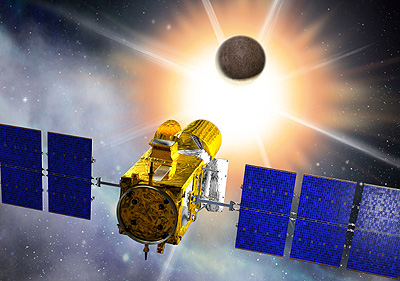[/caption]
The European Space Agency’s COROT spacecraft has discovered an unusual exoplanet orbiting a star slightly more massive than our Sun. The planet, currently called COROT-exo-4b, is about the same size as Jupiter, and it takes 9.2 days to orbit its star. Most peculiar however, is that the planet and the star are in sync: the star rotates at the same pace as the planet’s period of revolution. Astronomers feel the planet is too low in mass and too distant from the star for the star to have any major influence on the planet’s rotation. But they are trying to understand the special interaction between this star and planet.
COROT stands for Convection, Rotation and planetary Transits. Launched in 2006, the mission has now observed more than 50,000 stars. The spacecraft is designed to detect rocky exoplanets almost as small as Earth. The satellite uses transits, the tiny dips in the light output from a star when a planet passes in front of it, to detect and study planets. This is followed up by extensive ground-based observations.
COROT-exo-4b is the fifth exoplanet found by the COROT spacecraft. Monitoring continuously over several months, the team tracked variations in its brightness between transits. They derived its period of rotation by monitoring dark spots on its surface that rotated in and out of view. It takes 9.2 days for the planet to orbit its star, which so far, is the longest period for any transiting exoplanet ever found.
It is not known whether COROT-exo-4b and its star have always been rotating in sync since their formation about 1000 million years ago, or if the star’s rotation synchronized later. Studying such systems with COROT will help scientists gain valuable insight into star-planet interactions.
This is the first transiting exoplanet found with such a peculiar combination of mass and period of rotation. Astronomers believe there must be something unique about how it formed and evolved.
Original News Source: ESA


yeah I think they have it wrong as well.
Shouldn’t this be the other way around? Shouldn’t the planet be too low in mass and too distant to the star for the planet to have any major influence on the star’s rotation?
I would lean towards this planet having a solid core (my theory on some of these ‘hot jupiters’). It would be interesting to see any astrometry figures taken, and to know a bit more precisely how close this is to its star; obviously inside a ‘Mercury” orbit, but nothing is really stated.
As for the spin sync. Possibly a polarization attraction and or repulsion; either currently or in the past.
If current theory about hot jupiters are correct, then this planet migrated towards its star. Something had to bring them closer together.
Why do scientists name the planets after the satellites that found them? Are they being lazy?